Head-up Display Market Outlook for 2025 to 2035
The head-up display market is expanding steadily due to growing integration of advanced visualization technologies across automotive, aerospace, and defense sectors. Increasing demand for enhanced safety, situational awareness, and real-time data projection is driving market growth. Current developments are being influenced by rising adoption of augmented reality (AR) interfaces and improvements in projection optics, which are enhancing image clarity and display responsiveness.
Manufacturers are focusing on compact designs, improved brightness, and reduced latency to meet evolving customer requirements. The future outlook remains positive as consumer preference for connected and intelligent systems continues to grow. Rapid technological advancements in display materials and optical components are enabling better performance and energy efficiency.
Growth rationale is further supported by regulatory initiatives promoting driver assistance systems and the growing presence of digital cockpits in next-generation vehicles These factors collectively contribute to consistent market expansion and rising adoption of head-up displays across multiple end-use industries.
Quick Stats for Head-up Display Market
- Head-up Display Market Industry Value (2025): USD 14.0 billion
- Head-up Display Market Forecast Value (2035): USD 48.4 billion
- Head-up Display Market Forecast CAGR: 13.2%
- Leading Segment in Head-up Display Market in 2025: Display Panel (39.4%)
- Key Growth Region in Head-up Display Market: North America, Asia-Pacific, Europe
- Top Key Players in Head-up Display Market: Continental AG, BAE Systems, Denso Corporation, Honeywell Aerospace, Microvision, Inc., Nippon Seiki Co., Ltd., Panasonic Automotive Systems, Pioneer Corporation, Robert Bosch, Rockwell Collins, Saab, Thales Group, Visteon Corporation, Yazaki Corporation
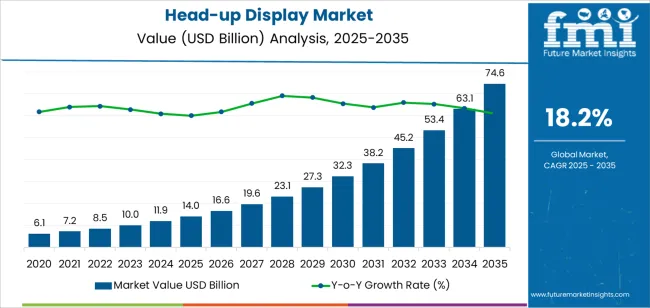
| Metric |
Value |
| Head-up Display Market Estimated Value in (2025 E) |
USD 14.0 billion |
| Head-up Display Market Forecast Value in (2035 F) |
USD 48.4 billion |
| Forecast CAGR (2025 to 2035) |
13.2% |
Segmental Analysis:
The market is segmented by Component, Technology, Application, and Type and region. By Component, the market is divided into Display Panel, Projection Unit, Video Generator, and Software. In terms of Technology, the market is classified into Liquid Crystal Display (LCD), CRT, Micro Electromechanical Systems (MEMS), DLP, LCOS, and Waveguide. Based on Application, the market is segmented into Automotive, Military and Defense, Civil and Aviation, and Others (Manufacturing, Wearable etc.). By Type, the market is divided into Windshield, Combiner, and Head-Mounted. Regionally, the market is classified into North America, Latin America, Western Europe, Eastern Europe, Balkan & Baltic Countries, Russia & Belarus, Central Asia, East Asia, South Asia & Pacific, and the Middle East & Africa.
Insights into the Component Segment:
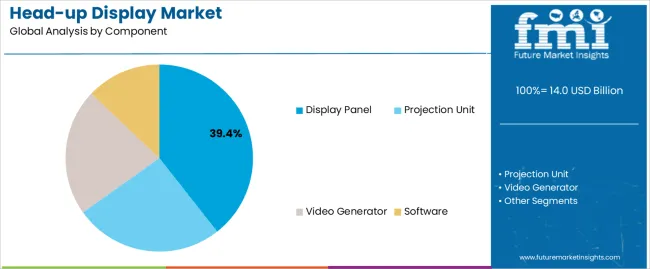
The display panel segment, accounting for 39.40% of the component category, has been leading the market owing to its pivotal role in image projection and visual clarity. Its dominance has been supported by continuous advancements in display resolution, color accuracy, and energy efficiency.
High adoption rates have been observed across automotive and aviation applications due to the segment’s ability to project critical data directly within the user’s line of sight. Manufacturers have been investing in transparent OLED and laser-based display innovations to improve brightness and reduce latency.
Durability and performance under diverse environmental conditions have also reinforced its preference among system integrators As consumer expectations for immersive visual experiences rise, the display panel segment is projected to maintain its leadership through technological refinements and integration with augmented and mixed-reality interfaces.
Insights into the Technology Segment:
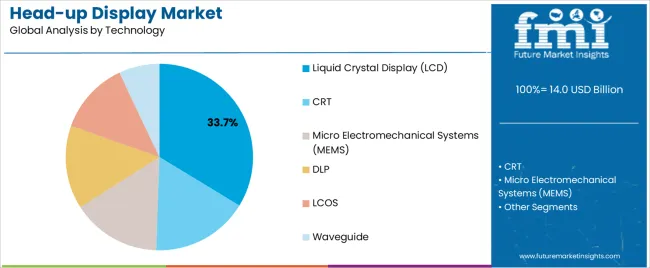
The liquid crystal display (LCD) technology segment, representing 33.70% of the technology category, has remained dominant due to its cost-effectiveness, mature production base, and consistent image quality. It has been widely adopted across automotive and aviation HUD systems where performance reliability and affordability are critical.
Advances in backlight technology and thin-film transistor designs have enhanced contrast and visibility, allowing LCD-based systems to meet stringent safety and clarity standards. The technology’s scalability and adaptability for both 2D and 3D HUD applications have supported its market share.
Continuous optimization for low-power operation and heat resistance has extended product lifecycle and ensured operational stability As newer display technologies evolve, LCD remains a preferred choice for mid-range and commercial HUD systems, sustaining its relevance and steady contribution to market growth.
Insights into the Application Segment
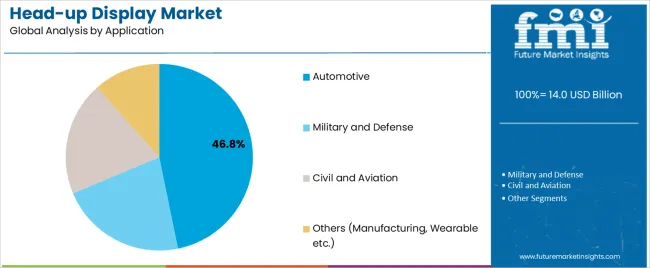
The automotive segment, holding 46.80% of the application category, continues to dominate the head-up display market as vehicle manufacturers increasingly integrate HUD systems to improve driver awareness and reduce distraction. Adoption has been reinforced by the growing implementation of advanced driver assistance systems and the push toward connected vehicle ecosystems.
HUDs enhance road safety by projecting speed, navigation, and sensor data directly within the driver’s field of vision. Automakers are focusing on expanding adoption beyond luxury models to mid-range vehicles, making HUDs more accessible to broader consumer groups.
Technological improvements in projection modules and augmented reality overlays are further enhancing usability and market appeal Regulatory initiatives promoting in-vehicle safety and the expansion of electric and autonomous vehicles are expected to support continuous growth of the automotive HUD segment across global markets.
Sales Analysis of the Head-up Display Market
- Head-up displays (HUDs) are transparent displays that display information in the driver's line of sight. Initially developed for aviation and military applications, they are increasingly used in automobiles, commercial aircraft, and wearables, driving the head-up display market.
- The head-up display industry is expanding mostly due to cheap product costs and simple smartphone interaction. By lowering distractions, these gadgets improve vehicle safety.
- Innovative technologies like global positioning systems (GPS), virtual reality (VR), and augmented reality (AR) may be linked with head-up display systems that drive industry demand in the forthcoming decade.
- The automotive industry is experiencing significant digitalization, particularly in head-up displays (HUDs), which is expected to boost demand across various applications in the coming decade.
- Sales of semi-autonomous and electric vehicles have surged, with voice commands aiding drivers in navigating hazards and global demand for automotive HUDs for electric vehicles.
- Increased purchasing power, tech-savvy consumers, increased safety awareness, rising disposable income, and the acceptance of advanced products, drive the head-up display industry’s growth.
Historical Performance and Future Growth of the Head-up Display Market
This study examines the head-up display market's growth over the past five years, revealing a historical CAGR of 16% and a projected 18.2% CAGR growth up to 2035, indicating a growing trend in the HUD market.
| Attributes |
Details |
| Head-up Display Market Historical CAGR for 2020 to 2025 |
16.0% |
Due to limited space and the need for complex redesigns, the head-up display industry faces challenges in achieving economies of scale and integrating head-up displays in vehicles. This space constraint is impeding the market share of head-up displays, as the HUDs require various hardware devices to be integrated into the cockpit.
Critical aspects that are anticipated to influence the demand for head-up display through 2035.
- HUDs, primarily used in automobiles, are gaining interest from gaming, aviation, and healthcare industries, potentially driving innovation and commercial expansion in the HUD sector.
- Advancements in optics, display technologies, and production procedures are leading to more affordable HUD solutions, increasing adoption across all car segments and driving global demand for head-up displays.
- ADAS, including head-up displays, is gaining popularity due to convenience and safety features, with market players leveraging lucrative opportunities to advance ADAS and drive demand for HUDs.
- Smart sensors integrated with HUDs enhance driving experiences by providing real-time data, driving market expansion, and improving vehicle diagnostics and traffic updates.
Market players are going to desire to be prudent and flexible over the anticipated period since these challenging attributes position the industry for accomplishment in subsequent decade.
Key Trends Influencing the Head-up Display Market
Integration of VR and AR Drives up the Demand for the Head-Up Displays
- Increased vehicle safety awareness drives demand for advanced technologies, such as VR- and AR-based head-up displays, which make driving more comfortable and safe.
- AR-based head-up displays (HUDs) enhance road navigation by superimposing digital data on real-world street views. These displays display navigation arrows, reducing driver distraction and improving navigation by superimposing digital data on the physical world.
- Customers seeking advanced features and technologies in their vehicles, particularly in emerging nations where the market for advanced luxury cars is rapidly expanding, primarily drive the rise in popularity of head-up displays (HUDs).
- Market players anticipate continued growth in the head-up display (HUD) market due to advancements in VR and AR features, enhancing the driving experience, and enhancing the technology's capabilities.
Racing Fandom Propels the Development in the Automotive Head-Up Displays
- The rise in racing enthusiasts' demand for immersive experiences has prompted manufacturers to develop advanced head-up displays (HUDs) that offer real-time data, enabling quick decision-making on the track.
- The racing industry's competitive landscape necessitates constant innovation, leading manufacturers to improve HUDs' accuracy, speed, and ease of use, enhancing their products.
- The racing industry's influence has influenced the consumer automotive market, incorporating advanced technologies like ADAS and safety features into race cars.
- Famous racing teams and tech companies are collaborating to advance HUD technology, creating sophisticated and accurate systems for drivers to stay ahead of the competition and ensure track safety.
- The racing industry is undergoing significant innovation due to the growing demand for immersive racing experiences, leading to the development of advanced and sophisticated HUDs.
Aviation Sector Skyrockets the Demand for the AR-Based Head-Up Displays
- The aviation industry is embracing advanced display technologies like Augmented Reality (AR)-based head-up displays (HUDs) for flight training due to safety concerns and regulatory pressures, enhancing pilot situational awareness and reducing cockpit workload during critical flight phases.
- Aerospace and tech firms are collaborating to develop advanced, reliable, cost-effective AR HUDs. These devices integrate sensors, machine learning algorithms, and real-time data processing, providing pilots with an intuitive view of aircraft surroundings.
- AR HUDs, widely used in commercial and military aircraft, are gaining popularity in other industries, such as transportation, logistics, and manufacturing.
- The advanced display technologies offer benefits beyond aviation, and their adoption is expected to rise in the coming decade due to safety and efficiency demands.
Category-wise Insights
This section offers in-depth analyses of particular head-up display market sectors. The two main topics of the research are the segment with the display panels as a component and the cathode ray tubes (CRT) technology.
Through a comprehensive examination, this section attempts to provide a fuller knowledge of these segments and their relevance in the larger context of the HUD market.
Display Panels Broadcasts 41.2% Global Market Share
| Attributes |
Details |
| Top Component |
Display Panel |
| Market share in 2025 |
41.20% |
The demand for display panels in the HUDs is significant, registering a market share of 41.20% in 2025; the following aspects display the development of display panels for the head-up displays:
- The market for head-up display (HUD) systems has grown significantly in recent years. Among the various components of the HUD system, demand for display panels are expected to develop at a faster pace.
- The market growth can be attributed to the display panel's critical role in the entire HUD system. The display panel is responsible for processing the image projected onto the vehicle's windshield for the driver to view.
- Vehicle manufacturers demand robust, integrated display panels for safety and security, providing accurate, real-time information to enhance the driving experience.
- Integrating advanced display panels with existing HUD systems can be complex due to its complexity and significant time and money investments, potentially deterring manufacturers and customers.
- Manufacturers should focus on creating cost-effective, easy-to-integrate display panels to meet the growing demand for HUD systems, presenting a significant opportunity for innovative solutions.
Demand for Cathode Ray Tubes (CRT) Rises with 24.2% Market Share
| Attributes |
Details |
| Top Technology |
Cathode Ray Tubes (CRT) |
| Market share in 2025 |
24.20% |
The head-up displays integrating CRT technology acquires a 24.20% market share in 2025. The development of cathode ray tubes for the HUDs from the following drivers:
- Cathode Ray Tubes (CRTs) are preferred for Head-Up Display (HUD) applications due to their reliability, longevity, and superior contrast ratios, making them ideal for industries like aviation and defense with specific requirements.
- Despite advancements in display technology, CRTs remain popular for niche applications requiring durability and performance, with demand increasing in recent years due to their viability in these specific applications.
- Advancements in CRT technology have enhanced their suitability for modern HUDs, sustaining demand and making them relevant for industries requiring high performance and reliability despite newer technologies.
Country-wise Insights
This section anticipates examining the markets for head-up display in some of the most important countries on the global stage, such as the United States, China, Germany, Japan, and Australia. Through in-depth research, explore the several aspects influencing these nations' acceptability and demand for HUDs.
| Countries |
CAGR from 2025 to 2035 |
| United States |
15.00% |
| Germany |
13.60% |
| Japan |
12.90% |
| China |
18.70% |
| Australia |
21.70% |
The United States Military Forces Demands for Conventional HUD
The United States military has developing the demand for conventional head-up display with a CAGR of 15% from 2025 to 2035. Here are a few of the major trends:
- Heads-up displays (HUDs) are crucial in United States military aircraft operations, providing pilots with real-time information for safe mission execution. Conventional HUDs are widely adopted due to their reliability and compatibility.
- In the United States, conventional HUDs improve pilot situational awareness by projecting critical information like altitude, airspeed, heading, and weapon status onto the pilot's line of sight, allowing quick access to crucial data.
- The United States military favors conventional HUDs due to their enhanced mission effectiveness, enabling pilots to make informed decisions and complete missions, and their extensive fleet necessitates their installation in various aircraft types.
- Conventional HUDs are essential for military aircraft operations, providing real-time information for safe mission execution. Their reliability, compatibility with existing systems and enhanced situational awareness make them the preferred choice for the United States military.
German Luxury Automobiles Demands for the Technological Advancements in the HUDs
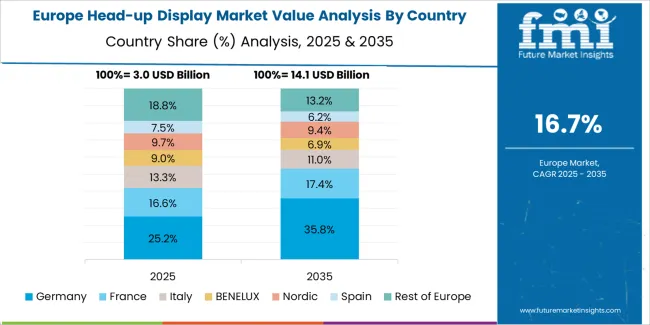
Demand for head-up display in Germany is expected to develop at a CAGR of 13.6%. The following factors are propelling the demand for head-up display in automotive sector:
- German luxury car manufacturers focus on developing HUDs to enhance driving experiences by projecting crucial information onto the windshield, ensuring drivers remain focused on the road.
- Luxury car brands in Germany, such as Audi, BMW, Mercedes, Porsche, and Volkswagen are integrating high-tech displays into their vehicles to meet consumer expectations for premium features, leading to increased investment in advanced HUDs to stay ahead of the curve.
- German luxury automakers are leveraging collaborations with technology companies and significant research to stay ahead in high-end vehicle (HUD) innovation.
- Such approach combines their expertise in luxury vehicle design with cutting-edge technology, resulting in advanced HUDs that cater to modern driver needs.
Marine Advancements in the Japan Develops Demand for Head-Up Displays
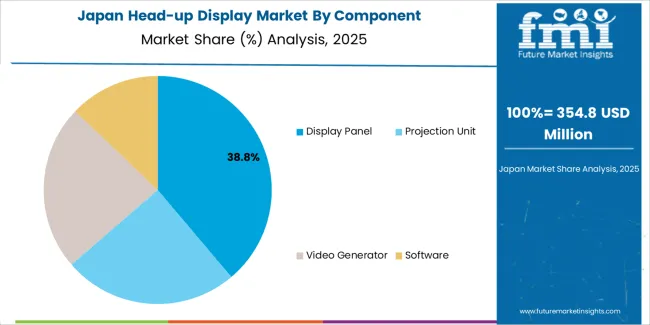
Japan demands technological development in head-up display in marine applications, and the demand for HUDs is predicted to extend at a CAGR of 12.9% between 2025 and 2035. Some of the primary trends in the industry are:
- Japan's marine industry is utilizing advanced human-visual aids to enhance navigation and safety in maritime vessels, providing real-time data overlay for improved situational awareness and navigation accuracy.
- Japan's maritime fleet is under increasing pressure to modernize and enhance due to technological advancements and global industry competition, requiring infrastructure, equipment, and training upgrades to ensure reliability, efficiency, and safety.
- The Japanese maritime sector embraces HUDs due to collaboration between marine manufacturers and technology firms. Advanced sensors, imaging technologies, and processing enhance HUD performance and reliability. Cutting-edge software tools facilitate seamless integration.
Chinese Manufacturing Sector Develops Demand for Wearable Head-Up Displays
The demand for head-up display in China is expected to register a CAGR of 18.7% from 2025 to 2035. Some of the primary trends are:
- China's manufacturing industry is experiencing a surge in demand for wearable head-up displays (HUDs) due to the need to enhance productivity and streamline operations.
- Wearable HUDs, such as VR glasses, are revolutionizing the industry by providing workers with hands-free access to real-time data and instructions, significantly enhancing efficiency.
- The trend is further propelled by the country's push towards Industry 4.0 and the increasing adoption of smart manufacturing technologies, transforming manufacturing in China.
Demand for Head-Up Displays Hits the Roof in the Australia
The head-up display industry in Australia is expected to register a significant CAGR of 21.7% by 2035. Among the primary drivers are:
- The increasing adoption of advanced technological systems in Australia's automotive sector is placing it as an attractive pocket in the global head-up display market.
- Australian carmakers are investing in research and development to improve their offerings with advanced safety features and driver assistance systems.
- Australia's defense and military sector is experiencing growth due to investments in advanced navigation and control systems, leading to increased defense and commercial jet sales.
Market players Shaping the Outlook of the Global Head-up Display Market
Leading companies in the head-up display market heavily invest in research and development to improve their products with advanced features such as augmented reality (AR) and artificial intelligence (AI). They are prioritizing the expansion of their product portfolios and diversification of their offerings to cater to the changing needs of their customers.
The focus is on developing connective technologies that can provide a seamless user experience and enable real-time information display with greater accuracy and speed. These advancements are expected to revolutionize the industry and enhance the general performance and functionality of head-up displays.
In addition to their research and development efforts, these leading companies are also pursuing mergers, acquisitions, and collaborations to gain a competitive edge in the market. By engaging in strategic partnerships, they aim to streamline development processes, optimize production workflows, and enhance their prevalent capabilities.
The companies aim to provide a seamless, high-quality user experience through innovative technology, focusing on customer satisfaction and exceptional products and services, setting the standard for the head-up display market and driving the industry forward.
Recent Developments in the Head-up Display Market
- In February 2025, Skoda introduced the Kushaq Explorer, a sportier SUV in India, featuring new cosmetics, a head-up display, 360-degree cameras, and an upgraded reverse camera with guidelines, offering an off-road-ready look.
- In December 2025, the FAA approved a supplemental type certificate for installing the AerAware enhanced flight vision system (EFVS) on the Boeing 737NG, developed by Universal Avionics and AerSale. The system offers enhanced, synthetic, and combined vision system imagery.
- In September 2025, Audi unveiled the interior of its Q6 e-tron electric SUV, which is expected to be the brand's most significant offering. The EV cabin is built on the Premium Platform Electric and E3 Electronics Architecture platforms, featuring an Audi MMI panoramic display, an OLED gauge cluster, an infotainment touchscreen, and a front-passenger-specific touchscreen.s
- In July 2025, German brand Tilsberk developed a unique head-up display (HUD) for bike enthusiasts, allowing them to monitor important information like gear positioning, RPM, speed limit, and petrol capacity from a virtual distance, using Sygic's Mobile SDK for personalized navigation.
- In June 2025, Saab signed a three-year collaboration agreement with Honeywell to transfer the Head-Up Display (HUD) assets for Honeywell's cockpit avionics systems, including the next-generation Honeywell Anthem integrated flight deck. The HUD enhances safety, situational awareness, and flight operations.
Key Companies in the Head-up Display Market
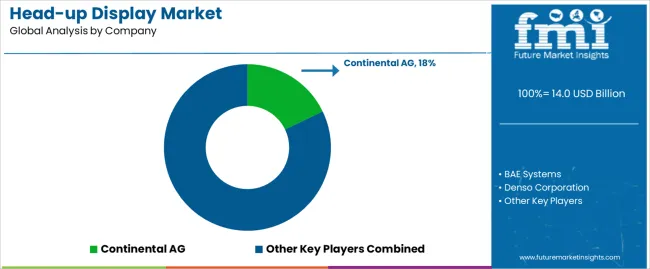
- BAE Systems
- Continental AG
- Denso Corporation
- Honeywell Aerospace
- Microvision, Inc.
- Nippon Seiki Co., Ltd.
- Panasonic Automotive Systems
- Pioneer Corporation
- Robert Bosch
- Rockwell Collins
- Saab
- Thales Group
- Visteon Corporation
- Yazaki Corporation
Key Coverage in the Head-up Display Market Report
- Rising Use of autonomous vehicles in the United States
- Growth Analysis of the Head-Up Displays in Military and Defense
- Top 10 Emerging trends in augmented reality HUD
- Price Analysis of Aviation HUD market and Military HUD market
- Sales Assessment of Wearable HUD market Forecast
Key Segments
By Component:
- Projection Unit
- Video Generator
- Display Panel
- Software
By Technology:
- CRT
- Micro Electromechanical Systems (MEMS)
- Liquid Crystal Display (LCD)
- DLP
- LCOS
- Waveguide
By Application:
- Military and Defense
- Civil and Aviation
- Automotive
- Others (Manufacturing, Wearable etc.)
By Type:
- Windshield
- Combiner
- Head-Mounted
By Region:
- North America
- Latin America
- Europe
- East Asia
- South Asia
- Oceania
- Middle East and Africa
Frequently Asked Questions
How big is the head-up display market in 2025?
The global head-up display market is estimated to be valued at USD 14.0 billion in 2025.
What will be the size of head-up display market in 2035?
The market size for the head-up display market is projected to reach USD 48.4 billion by 2035.
How much will be the head-up display market growth between 2025 and 2035?
The head-up display market is expected to grow at a 13.2% CAGR between 2025 and 2035.
What are the key product types in the head-up display market?
The key product types in head-up display market are display panel, projection unit, video generator and software.
Which technology segment to contribute significant share in the head-up display market in 2025?
In terms of technology, liquid crystal display (lcd) segment to command 33.7% share in the head-up display market in 2025.













